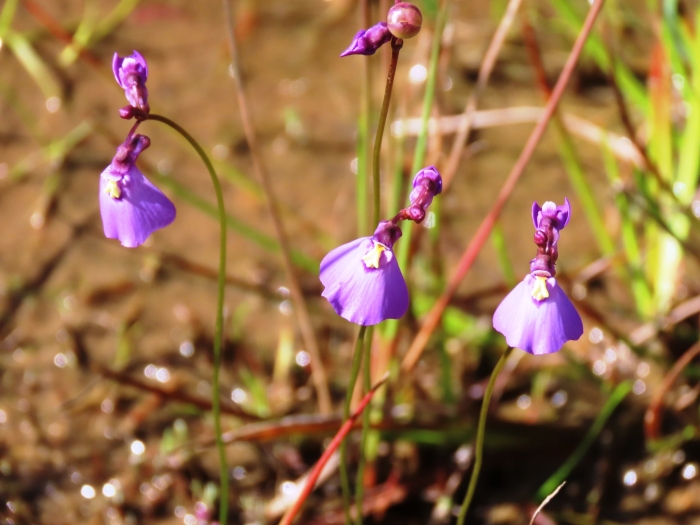Fairy Aprons
(Utricularia dichotoma)
Fairy Aprons (Utricularia dichotoma)
/
/

Elspeth Swan
CC BY 4.0
Image By:
Elspeth Swan
Recorded By:
Copyright:
CC BY 4.0
Copyright Notice:
Photo by: Elspeth Swan | License Type: CC BY 4.0 | License URL: http://creativecommons.org/licenses/by/4.0/ | Rights Holder: Elspeth Swan | Publisher: iNaturalist | Date Created: 2023-10-17T09:00:15-07:00 |

























Estimated Native Range
Summary
Utricularia dichotoma, commonly known as Fairy Aprons, is a perennial herbaceous bladderwort native to a variety of wetland habitats including bogs, fens, wet heathlands, and damp sandy soils in Australia, New Zealand, and New Caledonia. It typically forms mats with underground trailing stems that bear small, carnivorous bladders used to capture tiny aquatic prey. The species exhibits slender, wiry stems that can reach up to 20 inches in length, with inflorescences bearing distinctive mauve or purple fan-shaped flowers. These flowers, which bloom from August to April, feature a small upper petal and a broader lower lip with prominent markings, making them quite showy. The fruit is a globular capsule. Utricularia dichotoma was first described in 1805 by Jacques Labillardière.
Fairy Aprons is valued for its unique carnivorous nature and attractive flowers, making it a fascinating addition to water gardens, bog gardens, and as a specimen in terrariums or specialized aquatic setups. It requires consistently moist or wet conditions and prefers acidic soils with good drainage. Full sun to part shade is ideal for promoting vigorous growth and flowering. While generally not prone to diseases, it can be sensitive to water quality and requires nutrient-poor conditions to thrive.CC BY-SA 4.0
Fairy Aprons is valued for its unique carnivorous nature and attractive flowers, making it a fascinating addition to water gardens, bog gardens, and as a specimen in terrariums or specialized aquatic setups. It requires consistently moist or wet conditions and prefers acidic soils with good drainage. Full sun to part shade is ideal for promoting vigorous growth and flowering. While generally not prone to diseases, it can be sensitive to water quality and requires nutrient-poor conditions to thrive.CC BY-SA 4.0
Plant Description
- Plant Type: Herb
- Height: 0.2-0.6 feet
- Width: 0.5-1 feet
- Growth Rate: Moderate
- Flower Color: Pink, White
- Flowering Season: Summer, Spring
- Leaf Retention: Deciduous
Growth Requirements
- Sun: Full Sun, Part Shade
- Water: High, Aquatic
- Drainage: Standing
Common Uses
Low Maintenance, Potted Plant, Water Garden
Natural Habitat
Bogs, fens, wet heathlands, and damp sandy soils
Other Names
Common Names: Lavender Bladderwort, Pink Bladderwort
Scientific Names: , Utricularia dichotoma, Utricularia biflora, Utricularia dichotoma var. typica, Utricularia lilacina, Utricularia rotundifolia,
GBIF Accepted Name: